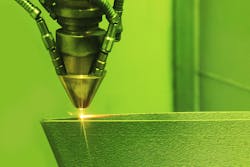Think “3D printing” in the lighting industry, and fully formed luminaires might spring to mind. But along with those, there are several promising and lesser known applications for the manufacturing technology, such as for heat sinks, electronic components, and optics.
Thus the conference running as part of the SPIE Optics + Photonics 2023 exhibition this Aug. 20–24 in San Diego will include a strand focused on 3D printing, examining how to use 3D across lighting components and systems.
Nadarajah Narendran, director of research for the Lighting Research Center (LRC) at Rensselaer Polytechnic Institute, will co-chair the 3D Printing for Lighting Conference — a sort of conference within a conference — in partnership with SPIE.
Narendran has identified a number of areas under exploration that he says are not yet being applied, such as 3D printing of the aforementioned electronic, optical, and thermal management components.
“We are definitely seeking abstracts from those who conducted research in these areas that can be relevant to lighting, even if lighting was not considered the original application,” he said.
The conference is reaching out to experts from both the lighting and 3D printing fields. At the time of publication the abstract deadline was March 8.
UPDATE: LEDs Magazine has learned that the event organizers will accept presentation proposals through the portal until March 19. For additional extension information, please contact LRC's program committee delegate Jean Paul Freyssinier.
“Abstract topics may include an overview of the state-of-the-art of 3D printing for lighting; design and digital tools to support adoption of 3D printing; uses of 3D printing relevant to lighting; applications and cases studies; and additional relevant topics,” LRC and SPIE said in jointly announcing the conference. LRC is based in Troy, N.Y.
SPIE, the self-described international society for optics and photonics, is based in Bellingham, Wash. Its new president, Bernard Kress, is the director of optical engineering for Google in augmented reality (AR) hardware. With career stops at both Google and Microsoft, he is also experienced in virtual reality (VR), smart glasses, wafer-based optics, and related areas such as micro and nano optics. Some LED companies, such as ams Osram, believe that LEDs and micro LEDs have a strong future in AR/VR and the so-called metaverse.
3D printing can have benefits in costs, environmental impact, customization, and quality. The technology is also known as additive manufacturing because it adds materials one layer at a time. The process itself has a photonics aspect, as it can involve laser sintering.
“Our goal is to bring awareness of the possibilities that 3D printing holds for lighting, to prompt new research in this field, and to help both lighting manufacturers and 3D printing technology manufacturers to work together,” Narendran said.
The 3D conference will run within SPIE’s optical engineering thread, one of three conference focuses that also include nanoscience and organic photonics.
3D luminaires have gained attention in recent years. The world’s largest lighting company, Signify, classifies them as a growth area, and has made them one of several legs of its sustainability agenda in both home and commercial markets.
A couple of Signify’s showcase 3D luminaire customers include Everlast Gyms in the U.K. and Bogotá’s El Dorado International Airport. In a double bout of sustainability, Signify uses 3D filament material made from discarded fishing nets to create a design-oriented pendant lamp collection that it calls Coastal Breeze.
MARK HALPER is a contributing editor for LEDs Magazine, and an energy, technology, and business journalist ([email protected]).
For up-to-the-minute LED and SSL updates, follow us on Twitter. You’ll find curated content and commentary, as well as information on industry events, webcasts, and surveys on our LinkedIn page and our Facebook page.






